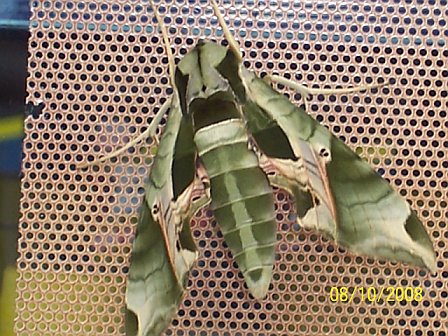Sphinginae subfamily
Sphingini tribe:
 |
This species is a strong migrant and adults nectar from deep-throated
flowers including moonflower (Calonyction aculeatum), morning
glory (Convolvulus), honey suckle (Lonicera) and
petunia (Petunia species).
|
 |
Ceratomia amyntor
WO,
the Elm Sphinx or Four-horned Sphinx
The upperside of the forewing is brown with dark brown and white
markings including a white costal area near the wing base, dark
streaks along the veins, and a white spot in the cell.
Larvae feed on Elm (Ulmus), birch (Betula), basswood (Tilia), and cherry (Prunus). |
 |
The upperside of the forewing is yellowish brown with no white
markings, but there are indistinct black lines and dashes. The cell
spot is gray with a black outline and the upperside of the hindwing
is yellowish brown with obscure lines. The larvae feed in large
groups and are much more spectacular than the moths.
Catalpa is
the larval host. |
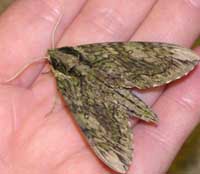 |
Ceratomia hageni
USGS,
Hagen's Sphinx or Osage Orange Sphinx
The upperside of the forewing is gray with a green tint and has dark
indistinct wavy lines, and pale gray patches at the wing tip and
along the costa. generally more eastern species |
 |
The upperside of the forewing is pale brownish gray with wavy black
and white lines and a black-outlined white cell spot.
|
 |
Dolba hyloeus
WO, the Pawpaw Sphinx
The upperside of the forewing is dark brown with a dusting of white
scales. Some moths have patches of reddish or yellowish brown on the
wings. generally more southeastern species in OK.
|
 |
Manduca quinquemaculata
WO, the Five-spotted Hawkmoth
The moth abdomen usually has five but sometimes six pairs of yellow
bands. The upperside of the forewing is blurry brown and gray.
Larvae feed on tomatoes and go by the common name of
"Tomato Hornworms". |
 |
Look for three large yellow spots
on each side of the abdomen. The upperside of the forewing is
yellowish brown to deep chocolate brown with a dusting of white
scales and zigzagged black and white lines.
generally more southeastern species in OK.
|
 |
Manduca sexta
WO, the Carolina Sphinx
The abdomen usually has six pairs of yellow bands, broken across the
back. The sixth set of markings is quite small.
The upperside of the forewing has indistinct black, brown and
white markings.
If you grow tomatoes, you have probably encountered it.
|
 | The upperside of the forewing is gray with indistinct black and
white markings. There is a series of black dashes
from the base to the tip, and a small white cell spot.
|
 |
Sphinx chersis
WO, the Northern Ash Sphinx or Great Ash
Sphinx
The upperside of the forewing is soft dark gray to
blue-gray with a series of black dashes, one of which reaches the
wing tip.
Larval hosts are ash, lilac, privet, cherry, and quaking aspen.
|
 |
Sphinx drupiferarum larvae hide in the day and feed primarily on
cherry, plum, and apple at night.
possibly |
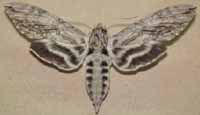 |
The upperside of the forewing is pale gray with a yellowish tint,
wavy black lines and dashes, and inconspicuous white spots.
probably rare if present; more central OK
|
 |
The upperside of the forewing has a narrow black subterminal line
bordered by a white inverted V-shaped line on the outside, and a
black line running inwards from the apex of the wing.
It is most often found in montane woodlands and along streamcourses.
|
Smerinthini Tribe:
 |
The adults are also highly variable; sometimes wings of an individual
may be all one color or may have several colors, ranging from pale to
dark brown, and may have a white or pink tinge.
See the file for the female; she is different. |
 |
Pachysphinx modesta
WO,
the Modest Sphinx or Poplar Sphinx,
This moth has a large, heavy body, and females
can be remarkably plump. remote possibility
|
 |
The grey-blue eyespot of the hindwing gives this species its name.
Larvae feed on birches, willows, cherries and oaks.
The outer edge of the forewings is quite scalloped. |
 |
This small species is probably widespread and common. This species ranges across North America.
The hindwings have a small blue eyespot ringed with black on a yellow background.
|
 |
Smerinthus jamaicensis closely resembles Smerinthus cerisyi, but
jamaicensis is much smaller with larger blue patches on
more vibrant and deeper purple in the lower wings.
|
Macroglossinae subfamily
Dilophonotini tribe
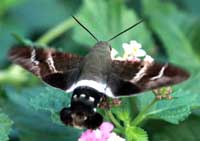 |
The body is dark brown with a wide white stripe across the abdomen.
The wings are dark brown. It is very similar to above species, but
the upperside of the hindwing has pale patches along the costa and
inner margin. maybe rare stray |
 |
The abdomen has very distinct gray and black bands.
Adults nectar at dusk so you may see them in the garen at that
time, but only as maybe rare strays. |
 |
During the night adults nectar at flowers, including bouncing bet
(Saponaria officinalis) and Asystasia gangetica beginning at dusk.
July and August are flight times in the southern states.
maybe rare strays
|
 |
Hemaris diffinis
USGS,
the Snowberry Clearwing or Bumblebee Moth
The wings are basically clear, with dark brown to brownish-orange
veins, bases and edges. The thorax is golden-brown to dark
greenish-brown. The abdomen tends to be dark (black) with 1-2 yellow
segments just before the end. |
 |
Hemaris thysbe
USGS, the Hummingbird Clearwing
It is not difficult to see why many gardeners would mistake an
Hemaris thysbe moth for a small hummingbird as it hovers, sipping
nectar from flowers through a long feeding tube.
|
Philampelini tribe:
 |
Eumorpha achemon
WO,
the Achemon Sphinx
Adults nectar from flowers of Japanese honeysuckle
(Lonicera japonica), petunia (Petunia hybrida),
mock orange (Philadelphus coronarius), and phlox (Phlox).
Larvae feed upon Grape (Vitis),
Virginia Creeper (Parthenocissus quinquefolia)
and other vines and ivies (Ampelopsis).
|
 |
This moth is a very strong flier and is often reported far north of
its normal range. An image of a mature larva sent from Mayes County, September 11, 2009, Rebecca Oliver.
|
 |
Eumorpha pandorus
EHT, the Pandorus Sphinx:
If you have Grape or Virginia Creeper nearby, then you probably have
this species. Upperside is light brown with shades of olive green to green. Fw has pink
streaks along vein ends and near inner margin.
Area from base to mid wing is dark green along inner margin.
|
Eumorpha pandorus, Langley, August 10, 2008, Eddene Hightower Thompson, Tim Roe, Janet, Shelby and TJ Jr..
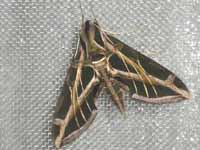 |
The upperside of the moth is dark pinkish brown. Each forewing has a
lighter brown band along the costa, and sharp pinkish white bands and
streaks. The hindwing has a pink patch on the inner margin.
unlikely stray
|
Macroglossini tribe
 |
This day flier is widely distributed. If you have Virginia Creeper, you
probably have the Nessus Sphinx. It is reported from
Hunterdon.
Two bright, distinct, narrow yellow
bands are often visible on the abdomen.
|
 |
The lower wings of this hawkmoth are a solid brownish-orange,
matching the body colour.
You will often see this species listed as Darapsa pholus,
especially in older literature.
|
 |
Darapsa myron
USGS, the Virginia Creeper Sphinx or the Grapevine Sphinx
The forewing upperside is dark brown to pale yellowish gray, with an olive tint.
On the costal margin there is a dark rectangular patch, although this may be reduced or absent.
The upperside of the hindwing is pale orange. |
 |
The moth's outer margin of the forewing is deeply scalloped.
The upperside is light brown with dark brown markings.
There is a small black and white spot near the tip.
The upperside of the hindwing is orange-brown with a dark brown outer margin and median line.
|
 |
Hyles lineata WO, the White-lined Sphinx
This species is very widespread. It can be seen flying during the day,
into the evening and also at night.
The highly variable larvae are often found in people's gardens. |
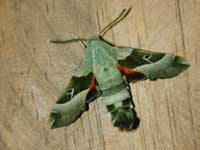 |
The upperside of the forewing is pale gray-green with a deep
green-brown median area and a white dash at the wing tip. The
underside of the forewing is pale orange at the base.
|
 |
This moth is very much under reported across the United States. It
is a rapid day flier so is probably not in too many collections.
Grape is a popular larval host. generally more eastern species
|
 |
The upperside of the forewing is pale brown with lavender-gray at the
base and has dark brown lengthwise lines throughout. The upperside of
the hindwing is dark brown with a band of whitish, wedge-shaped
marks.
|
|
|
